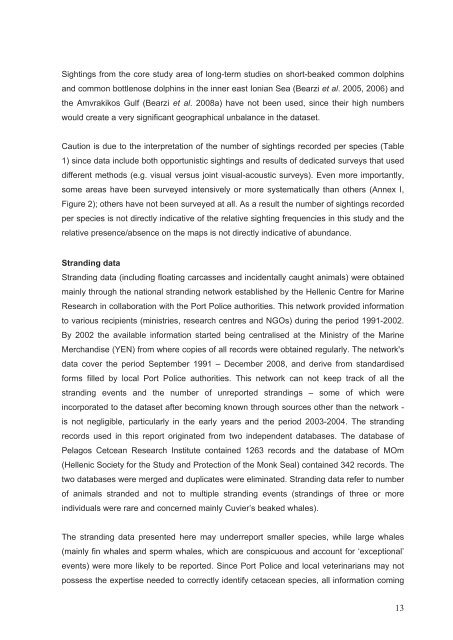Cetaceans in Greece: Present status of knowledge
Cetaceans in Greece: Present status of knowledge
Cetaceans in Greece: Present status of knowledge
Create successful ePaper yourself
Turn your PDF publications into a flip-book with our unique Google optimized e-Paper software.
Sight<strong>in</strong>gs from the core study area <strong>of</strong> long-term studies on short-beaked common dolph<strong>in</strong>s<br />
and common bottlenose dolph<strong>in</strong>s <strong>in</strong> the <strong>in</strong>ner east Ionian Sea (Bearzi et al. 2005, 2006) and<br />
the Amvrakikos Gulf (Bearzi et al. 2008a) have not been used, s<strong>in</strong>ce their high numbers<br />
would create a very significant geographical unbalance <strong>in</strong> the dataset.<br />
Caution is due to the <strong>in</strong>terpretation <strong>of</strong> the number <strong>of</strong> sight<strong>in</strong>gs recorded per species (Table<br />
1) s<strong>in</strong>ce data <strong>in</strong>clude both opportunistic sight<strong>in</strong>gs and results <strong>of</strong> dedicated surveys that used<br />
different methods (e.g. visual versus jo<strong>in</strong>t visual-acoustic surveys). Even more importantly,<br />
some areas have been surveyed <strong>in</strong>tensively or more systematically than others (Annex I,<br />
Figure 2); others have not been surveyed at all. As a result the number <strong>of</strong> sight<strong>in</strong>gs recorded<br />
per species is not directly <strong>in</strong>dicative <strong>of</strong> the relative sight<strong>in</strong>g frequencies <strong>in</strong> this study and the<br />
relative presence/absence on the maps is not directly <strong>in</strong>dicative <strong>of</strong> abundance.<br />
Strand<strong>in</strong>g data<br />
Strand<strong>in</strong>g data (<strong>in</strong>clud<strong>in</strong>g float<strong>in</strong>g carcasses and <strong>in</strong>cidentally caught animals) were obta<strong>in</strong>ed<br />
ma<strong>in</strong>ly through the national strand<strong>in</strong>g network established by the Hellenic Centre for Mar<strong>in</strong>e<br />
Research <strong>in</strong> collaboration with the Port Police authorities. This network provided <strong>in</strong>formation<br />
to various recipients (m<strong>in</strong>istries, research centres and NGOs) dur<strong>in</strong>g the period 1991-2002.<br />
By 2002 the available <strong>in</strong>formation started be<strong>in</strong>g centralised at the M<strong>in</strong>istry <strong>of</strong> the Mar<strong>in</strong>e<br />
Merchandise (YEN) from where copies <strong>of</strong> all records were obta<strong>in</strong>ed regularly. The network's<br />
data cover the period September 1991 – December 2008, and derive from standardised<br />
forms filled by local Port Police authorities. This network can not keep track <strong>of</strong> all the<br />
strand<strong>in</strong>g events and the number <strong>of</strong> unreported strand<strong>in</strong>gs – some <strong>of</strong> which were<br />
<strong>in</strong>corporated to the dataset after becom<strong>in</strong>g known through sources other than the network -<br />
is not negligible, particularly <strong>in</strong> the early years and the period 2003-2004. The strand<strong>in</strong>g<br />
records used <strong>in</strong> this report orig<strong>in</strong>ated from two <strong>in</strong>dependent databases. The database <strong>of</strong><br />
Pelagos Cetcean Research Institute conta<strong>in</strong>ed 1263 records and the database <strong>of</strong> MOm<br />
(Hellenic Society for the Study and Protection <strong>of</strong> the Monk Seal) conta<strong>in</strong>ed 342 records. The<br />
two databases were merged and duplicates were elim<strong>in</strong>ated. Strand<strong>in</strong>g data refer to number<br />
<strong>of</strong> animals stranded and not to multiple strand<strong>in</strong>g events (strand<strong>in</strong>gs <strong>of</strong> three or more<br />
<strong>in</strong>dividuals were rare and concerned ma<strong>in</strong>ly Cuvier’s beaked whales).<br />
The strand<strong>in</strong>g data presented here may underreport smaller species, while large whales<br />
(ma<strong>in</strong>ly f<strong>in</strong> whales and sperm whales, which are conspicuous and account for ‘exceptional’<br />
events) were more likely to be reported. S<strong>in</strong>ce Port Police and local veter<strong>in</strong>arians may not<br />
possess the expertise needed to correctly identify cetacean species, all <strong>in</strong>formation com<strong>in</strong>g<br />
13


